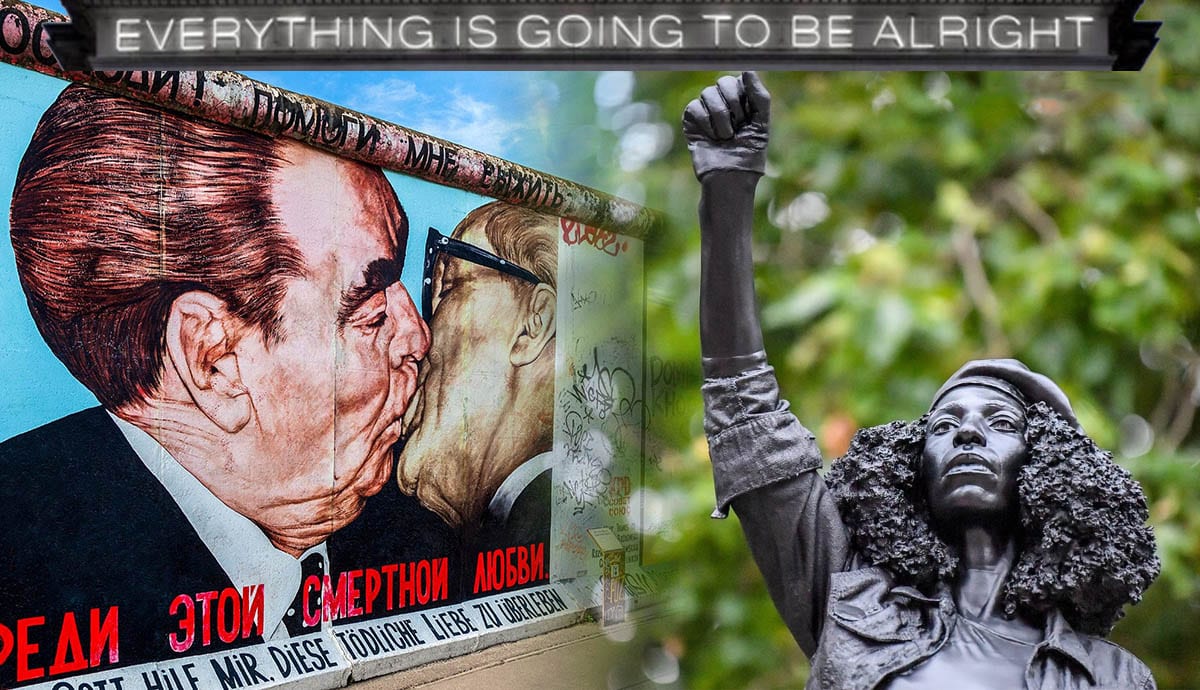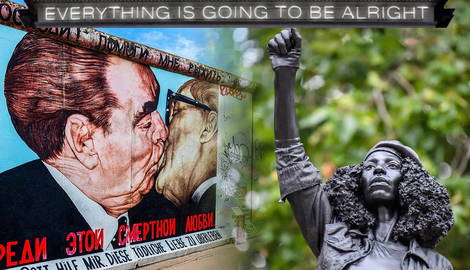
Public art extends beyond the gallery space and out into the real world, engaging huge audiences from all walks of life. No longer confined to commemorative statues featuring men and horses, contemporary artists have broadened the scope of public art to encompass a wide range of media, from mirrored abstractions to acts of political protest. Because public money often funds the production of public art opinions can be divided, particularly if the art changes the use of public space.
But much of today’s best public art is aimed at engaging directly with communities and highlighting local or national issues – some public artworks have even led to urban redevelopment projects or social reform. Various foundations have been established to encourage the ongoing development of temporary and permanent public art projects including The Public Art Fund in New York, The Greater Des Moines Public Art Foundation in Iowa and The Association for Public Art in Philadelphia. Below are 6 reasons why we need public art in modern society.
A Brief History Of Public Art

Public art has been in existence since antiquity. Some of the earliest forms in Roman and Renaissance times were stonework or statues commemorating Emperors, royalty, or mythical characters as God-like figures looking down on the public from on high. The 18th and 19th centuries continued with this tradition of mostly male leaders as idealized and intimidating totems of absolute power, many of which still exist in cities around the world although some portraying the most problematic figures have been vandalized, removed or destroyed.
During the 20th and 21st century the scope of public art widened dramatically. Greater political purpose was invested into public art projects, as seen in the idealistic propaganda art of Soviet Socialist Realism, nationalist Mexican murals, and Chinese art around the Cultural Revolution. One of the most prominent and contentious sites for impromptu public art was the Berlin Wall, part of which still exists as an open-air site known as the East Side Gallery preserved by the Berlin Wall Foundation.

Towards the later 20th century the rise of land art, street art, performance and graffiti shaped a whole new approach to public art, in which the inaccessible mounted monument was replaced with engagement and interactivity. German artist Joseph Beuys made temporal interventions aimed at reawakening our ecological conscience such as 7,000 Oaks, 1982. Feminist artists including Barbara Kruger and the Guerrilla Girls explored propaganda-style posters spurring viewers into action. Keith Haring’s brilliantly colored murals focused on urban regeneration. Since this time the many roles of public art continue to expand in new directions, but almost always with a moral or social conscience. Let’s take a look at some of the most important reasons why we still need this democratic and politically aware art form today.
To Enliven Public Spaces

One of the most accessible and engaging roles of public art today is to enliven or regenerate public spaces. As well as transforming sites through vivid colors and dazzling patterns, many public art forms also invite deeper theoretical contemplation of the setting around it. Sarah Morris’ site-specific installation Robert Towne, 2006-07, covered the ceiling on the open-plan ground floor of Lever House in New York’s Park Avenue.
Although the building designed by Gordon Bunshaft in 1951 is recognized as an iconic landmark, his choice to leave the entire ground level as an open arcade for public use prompted controversy, with many labeling it too dark, dangerous and unusable. Morris’ dazzlingly bright installation brings this once gloomy, brutalist site alive with intersecting shards of color and line inspired by the architecture and color of L.A. In doing so she invites us to draw comparisons between the two leading yet architecturally diverse cities of New York and L.A. In a further nod to L.A., she titled the work after the legendary Hollywood writer, director, producer, and actor Robert Towne.
Igniting A Political Cause

Since the 1960s many artists have taken up guerrilla-style public art protests in support of political causes, from poster campaigns to impromptu performances and pop-up interventions. And as they have proved, art is one of the most powerful and evocative means of drawing attention. Chinese artist Ai Weiwei is no stranger to controversy and has made a career from merging political activism with art. In 2017, he gathered 14,000 discarded orange life jackets once worn by refugees and hung them on the exterior pillars of Konzerthaus Berlin in Germany. He dedicated the provocative installation to refugees who had died at sea in a bid to escape the war-torn Middle East and North Africa, raising awareness of the incomprehensively vast scale of the humanitarian crisis.

More recently, when a Black Lives Matter group of protestors pulled down a statue of slave trader Edward Colston in Bristol, England 2020, they left an empty plinth behind. British artist Marc Quinn saw an opportunity and seized it, quickly producing a resin and steel sculpture of the young black female activist Jen Reid with her arm raised in defiance. Without waiting for permission, Quinn sneaked out in the middle of the night and installed his sculpture of Reid on the empty plinth, commenting, “it’s time for direct action now.” Although Quinn’s sculpture was later removed, his message was heard loud and clear, attracting a frenzy of media attention.
A Warning About The Future

Given the enormity of the climate change crisis, it’s perhaps no surprise that artists have chosen to address the subject through public art. One of the most direct and confrontational projects was Danish-Icelandic artist Olafur Eliasson’s Ice Watch, which he created for sites in Copenhagen, Paris, and London between 2014 and 2018. To create the work, he hacked twelve huge blocks of glacial ice off the Greenland ice sheet and transported them to prominent urban sites before arranging them into a clock formation. As the ice slowly melts, viewers are confronted with the tangible reality of melting arctic ice as it disappears forever, while the clock arrangement reinforces the inevitable passage of time.
To Create A Spectacle

Some of the most memorable public art is wild, playful, and ridiculous, allowing us to transcend the ordinary into a child-like realm of spectacle and wonder. Anish Kapoor’s immense sculpture Cloud Gate, 2004, aka “the bean” was made for Chicago’s Millennium Park from a whopping 168 stainless steel plates and stands over 10 meters tall and 20 meters wide. Despite its colossal size, the mirrored surface gives Kapoor’s iconic landmark a lucid, weightless quality, while its curved contours stretch and distort the cityscape around it into constantly shifting patterns of color and light.

This same quality of spectacle was embraced by the late artistic duo Christo and Jeanne-Claude from the 1960s until Christo’s passing in 2020. The huge London Mastaba, 2018, was installed in London’s Serpentine Lake and made from an astonishing stack of over 7,000 painted, stacked barrels in a dizzying array of acid-bright colors. The barrels were arranged on a steel frame to resemble the mastabas or early flat-roofed structures from the ancient city of Mesopotamia. But ultimately, Christo argues it is the formal qualities that matter most, noting, “The colors will transform with the changes in the light and its reflection on the Serpentine Lake will be like an abstract painting.”
Bringing Hope

Beyond grand gestures and ardent politics, much of today’s public art taps into our most vulnerable needs and desires, communicating powerful messages of hope or reassurance. Much-celebrated graffiti artist Banksy’s stenciled mural Girl with Balloon, 2002 is one of the most popular and iconic motifs of the 21st century. Originally made for the South Bank Bridge in London, it features a young girl reaching towards a red, heart-shaped balloon that is swept away by the wind, accompanied by the simple slogan “there is always hope.” The innocence of the young girl and the brilliant red of her heart-shaped balloon came to encapsulate our deep-rooted need for love, security, and freedom. Although the original work was an act of vandalism that was later removed, the image lives on through digital reproductions.

Like Banksy, British artist Martin Creed explores the open-ended emotional resonance of text in public art. His neon text artwork Work No. 203: EVERYTHING IS GOING TO BE ALRIGHT, 1999, was designed for the façade of the Clapton Portico in Hackney, East London, but he has since reconfigured further versions of the work for a range of other locations. This original site at the Portico once housed the London Orphan Asylum before being bought by The Salvation Army, but in more recent times, the building had fallen into a state of disrepair.
Creed’s text art offered hope for this abandoned site, and the building has since been converted into part of Clapton Girls Academy. But as with much of Creed’s work, there is a hint of underlying insecurity hiding beneath his text, highlighting the need for reassurance. As writer Dave Beech observes, “the neon says everything is going to be alright but the art is not so sure.”
Memorials To The Past

The most traditional role of public art as a commemorative memorial is still in existence today, serving as a potent and sometimes harrowing reminder of the past. British sculptor Rachel Whiteread’s solemn and atmospheric Judenplatz Holocaust Memorial, 2000, in Vienna, also known as “the nameless library,” encapsulates how public art can carry this weighty position of collective remembrance. Dedicated to the thousands of victims of Nazism, this huge, austere slab of concrete looks like a closed, inaccessible building lined with row upon row of books turned inwards to the wall so we see only their closed pages.
Resembling the private chambers of an underground military bunker, this eerily silent, secretive monument highlights just how many stories will go untold and unread. But it stands as an enduring, permanent testament to the insurmountable loss of life and as writer Adrian Searle observes, “It will not disappear into forgetfulness or the every day. It is a place where memories happen.”
Legacy Of Public Art
The scope of public art continues to expand in unprecedented directions as artists build on the powerful and emotive legacy of their predecessors. Through the support and funding of public art foundations and local government, artists continue to bring ever more adventurous temporary and permanent art projects out into the open air in cities and public spaces around the world. Beyond the traditional gallery, art can communicate and connect with the public on a more direct, confrontational, and intimate level, inviting us to see the world around us in new and unexpected ways.










